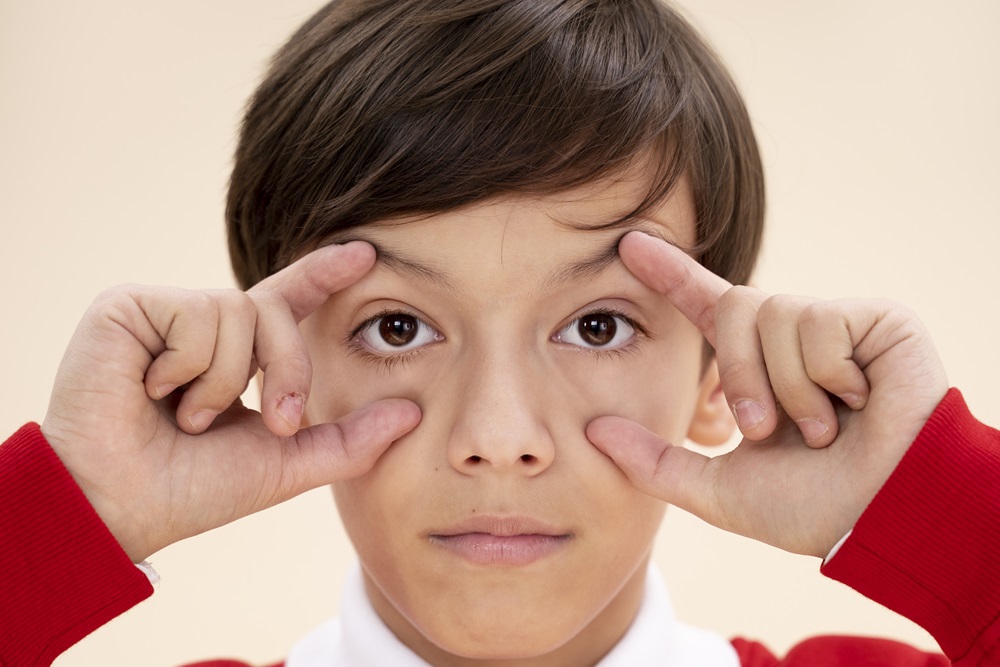The upper eyelid droops over the eye, partially or fully covering the pupil.
It can be mild (slight drooping) or severe (covering the pupil entirely).
Ptosis can interfere with vision and cause cosmetic concerns.
Asymmetrical eyelids: One eyelid appears lower than the other.
Difficulty opening the eye: The child may struggle to lift the affected eyelid.
Head tilting or eyebrow raising: The child may tilt their head back or raise their eyebrows to see better.
Amblyopia (lazy eye): Severe ptosis can block vision, leading to poor visual development.
Eye fatigue or headaches: Due to overuse of the muscles to keep the eyelid open.
Caused by underdeveloped or weak levator muscles (the muscles that lift the eyelid).
Often present at birth and may be genetic.
Trauma: Injury to the eyelid or eye muscles.
Neurological conditions: Diseases like myasthenia gravis or third nerve palsy.
Eye tumors or masses: Growths that weigh down the eyelid.
Infections or inflammation: Conditions like blepharitis or chalazion.
Physical examination: The doctor assesses the eyelid position and muscle strength.
Vision tests: To check for amblyopia or other vision problems.
Neurological evaluation: If acquired ptosis is suspected, neurological tests may be required.
Imaging studies: In rare cases, MRI or CT scans may be needed to rule out tumors or other structural issues.
Levator muscle surgery: Tightening or repositioning the levator muscle to lift the eyelid.
Frontalis sling surgery: Connecting the eyelid to the forehead muscle (frontalis) to help lift it.
Surgery is usually recommended for moderate to severe ptosis, especially if it affects vision.
Patching therapy: If amblyopia is present, patching the stronger eye can help improve vision in the weaker eye.
Glasses or contact lenses: To correct any refractive errors.
If ptosis is caused by an underlying condition (e.g., myasthenia gravis), treating the condition may improve eyelid position.
Monitor your child’s eyelid position and vision regularly.
Seek medical attention if you notice drooping, asymmetry, or vision problems.
Follow the prescribed treatment plan and attend all follow-up appointments.
Provide emotional support, especially if surgery is required.
Turkey is a leading destination for medical tourism, offering advanced treatments for eyelid drooping (ptosis) at affordable costs. Here’s what you need to know about managing this condition in Turkey:
Expert Ophthalmologists: Turkey has highly skilled pediatric ophthalmologists specializing in ptosis surgery.
Advanced Technology: Hospitals are equipped with state-of-the-art diagnostic and surgical tools.
Affordable Costs: Treatment costs in Turkey are significantly lower than in many Western countries.
Comprehensive Care: From diagnosis to post-treatment follow-up, Turkish healthcare providers offer holistic care.
Levator muscle surgery and frontalis sling surgery.
Minimally invasive techniques for faster recovery.
Patching therapy and corrective lenses.
Research and choose a reputable hospital or clinic with experience in pediatric ptosis.
Consult with a specialist to determine the best treatment plan for your child.
Plan for a stay of at least 1-2 weeks for surgery and follow-up appointments.
Check if your insurance covers international treatments or inquire about hospital payment plans.
Child eyelid drooping (ptosis) is a treatable condition, and early intervention is key to preventing complications like amblyopia. Whether you seek treatment locally or consider Turkey for its advanced medical care, the most important step is consulting a qualified ophthalmologist. With the right treatment, children with ptosis can achieve improved vision and a better quality of life.
If you have further questions or need assistance, feel free to reach out to a healthcare professional or a trusted medical tourism agency in Turkey.
